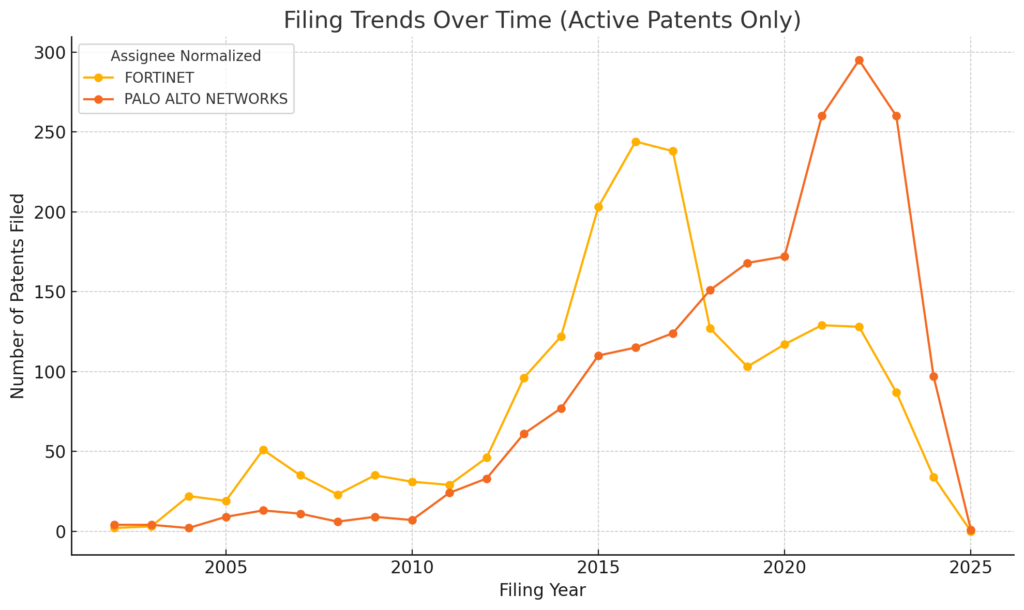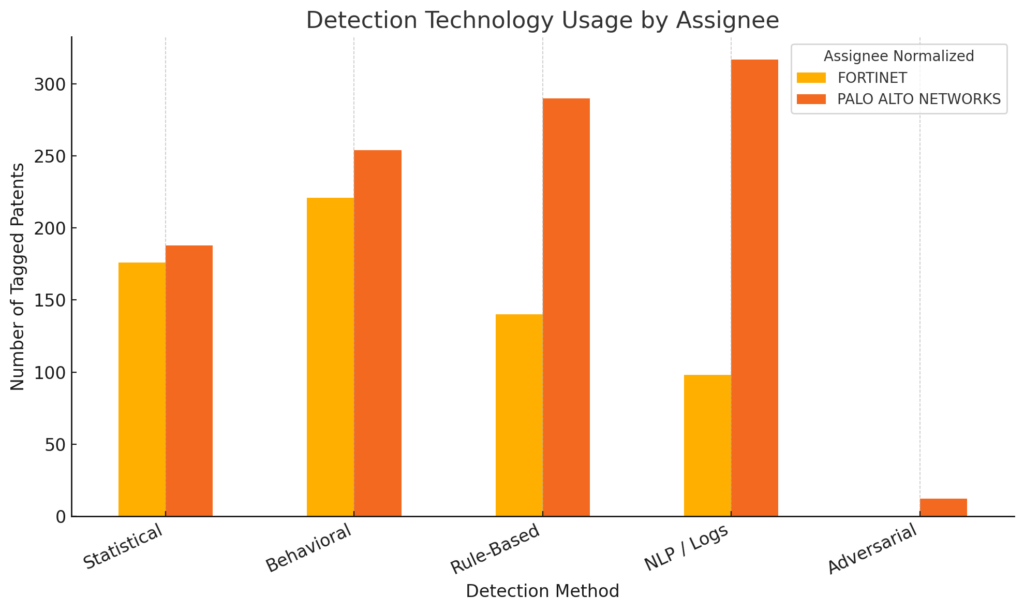Fortinet vs. Palo Alto Networks: A Mini Patent Landscape on AI-Driven Detection Technologies

As cybersecurity threats evolve, so do the technologies used to detect and mitigate them. This mini patent landscape explores how two of the world’s leading cybersecurity firms — Fortinet Inc. and Palo Alto Networks Inc. — are innovating in the field of AI-driven threat detection technologies.
We analyze all active patents and published applications filed by these companies up to April 7, 2025, focusing specifically on five key detection approaches in artificial intelligence and machine learning:
- Statistical & Anomaly Detection
- Behavioral Pattern Recognition
- Rule-Based + ML Hybrid (Heuristic Augmentation)
- Natural Language & Unstructured Log Analysis
- Adversarial Threat Detection
By examining patent filing trends, technology preferences, and detection method focus, this landscape offers insights into each company’s strategic direction and innovation depth in AI-enhanced cybersecurity.
Comparing the Broader Patent Portfolios of Fortinet vs. Palo Alto Networks
Before zooming in on detection-specific technologies, it’s important to understand the overall patent activity and strategic posture of both companies in cybersecurity innovation. The following trends emerge from an analysis of all active patents and applications filed up to April 7, 2025.
Total Active Patents / Applications
| Company | Active Patent Count |
| Palo Alto Networks | 2,013 |
| Fortinet | 1,924 |
While the total patent counts are closely matched, this surface similarity conceals differences in filing behavior and technology emphasis explored below.
Filing Trends Over Time
This line chart highlights how the two companies have built their portfolios over the years.

Note: In the above chart the term “Patents” include both Granted Patents and Patent applications.
Observed Insights:
Palo Alto Networks shows a more sustained and linear growth in filings, suggesting a steady IP development strategy.
Fortinet exhibits sharper increases during certain years, which may reflect strategic bursts aligned with product development cycles or acquisitions.
Both companies show continued innovation into the 2020s, reflecting the growing importance of AI-driven detection in cybersecurity.
Detection Technology Usage by Assignee
Within the broader cybersecurity patent portfolios of Palo Alto Networks Inc. and Fortinet Inc., we isolated a subset of patents that disclosed at least one of five key AI-based threat detection methods. This subset — referred to as Detection Methods Patents — reveals how each company is investing in next-generation threat detection technologies.
Detection Method Patents Count
| Company | Detection Method Patents |
| Palo Alto Networks | 796 |
| Fortinet | 728 |
These patents represent inventions where at least one AI-driven detection method (e.g., statistical anomaly detection, behavioral analysis, NLP-based log interpretation) was discussed.
Detection Method Taxonomy
| Detection Method | Tagging Criterion (Yes/No Check) |
| 1. Statistical & Anomaly Detection | Does the invention detect threats by identifying statistical deviations from a learned baseline of normal behavior, without using predefined attack patterns? |
| 2. Behavioral Pattern Recognition | Does the invention analyze or learn time-evolving behavior patterns of users, devices, or processes to detect threats? |
| 3. Rule-Based + ML Hybrid (Heuristic Augmentation) | Does the invention enhance or adapt human-defined rules (e.g., signatures, heuristics) using machine learning or statistical models? |
| 4. Natural Language & Unstructured Log Analysis | Does the invention use NLP or parsing techniques to extract meaning from unstructured inputs like logs, alerts, or textual reports? |
| 5. Adversarial Threat Detection | Does the invention detect or defend against attacks targeting the AI/ML model itself, such as adversarial inputs, evasion, or model poisoning? |
These tagging rules were developed to ensure minimal overlap between categories, while covering the broadest spectrum of AI-based threat detection methods relevant to enterprise and network security contexts.
Detection Method Breakdown by Company
This chart shows how frequently each detection method appears in the patents of the two companies.

Note: In the above chart the term “Patents” include both Granted Patents and Patent applications.
Observed Insights:
Palo Alto Networks Inc. shows a strong lead in:
- Rule-Based + ML Hybrid Detection
- Natural Language & Unstructured Log Analysis
- It is also the only company with patents tagged for Adversarial Threat Detection, albeit in a modest number.
In Statistical & Anomaly Detection and Behavioral Pattern Recognition, both companies show comparable investment, suggesting these are foundational approaches common to both portfolios.
Overall, Palo Alto Networks appears to prioritize more sophisticated AI integration and log analysis, while Fortinet maintains a balanced presence across core detection techniques.
Conclusion
This mini patent landscape provides a focused comparison of Palo Alto Networks Inc. and Fortinet Inc. in the fast-evolving domain of AI-driven threat detection technologies. By analyzing only active patents and applications up to April 7, 2025, we aimed to surface recent, enforceable innovation activity — not just legacy filings.
Key Takeaways:
- Portfolio Size: Both companies have a comparable number of active patents, with Palo Alto Networks slightly ahead (2,013 vs. 1,924).
- Detection Method Patents: A significant portion of each portfolio includes at least one AI-driven detection technique, with Palo Alto Networks again slightly ahead (796 vs. 728).
- Technology Focus:
- Palo Alto Networks leads in hybrid rule-based detection, log/NLP analysis, and adversarial detection, showing depth in modern AI integration.
- Fortinet demonstrates solid coverage of statistical anomaly detection and behavioral modeling, signaling a strong foundation in baseline analytics.
Strategic Implication:
While both companies are clearly investing in AI-enhanced threat detection, their technical paths diverge:
- Fortinet leans toward core detection fundamentals, whereas
- Palo Alto Networks appears to be pushing into augmented intelligence, log parsing, and AI model integrity.
This divergence may reflect broader product strategy philosophies — with Fortinet staying lean and efficient, and Palo Alto expanding into broader, AI-integrated detection ecosystems.
📬 Want the Full Dataset or a Custom Patent Landscape?
Are you interested in:
- Getting access to the Excel dataset behind this mini landscape?
- Exploring similar patent landscapes for your competitors or market niche?
- Building customized dashboards to track innovation trends over time?
👉 Crimson Insights offers tailored patent landscapes, IP benchmarking, and data-driven tech intelligence across global markets.
📧 Reach out at info@crimsoninsights.com
We’d be happy to share the dataset or help you build a landscape that fits your strategy.
